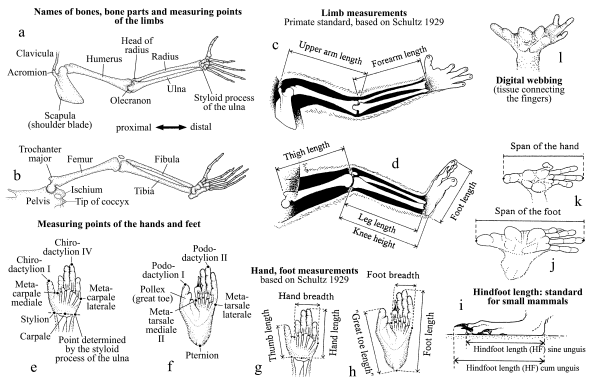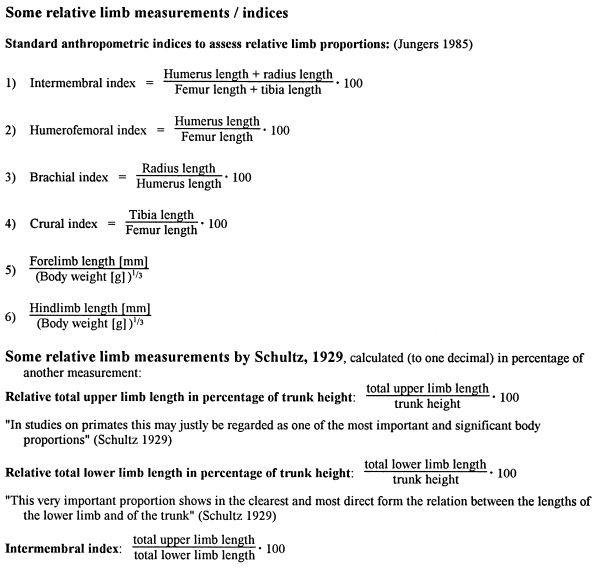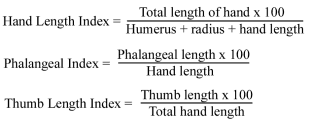
Click to enlarge view
| Home |
|
|
|
|

Definitions for standardized measuring and description of the limbs and postcranial skeleton and measurements found in loris and potto literature
Measuring points on the limbs:
Dactylion: the most distal point on the soft tissue of finger (Chirodactylion) or toe (Pododactylion), not considering the nail. Example: Chirodactylion IV = tip of the fourth finger (Based on Schultz 1926, changed)
Metacarpale mediale: the most medial point overlying the capitulum of the metacarpal bone of second digit.
Metacarpale laterale: the most lateral point overlying the capitulum of the metacarpal bone of fifth digit.
Metatarsale mediale II: the most medial point overlying the capitulum of the metatarsal bone of second toe. The point is, as a rule, more easily located by beginning with palpation on the dorsal, rather than on the plantar side of the foot.
Metatarsale laterale: the most lateral point overlying the capitulum of the metatarsal bone of firth toe.
Pternion: that point on the heel, overlying the tuber calcanei, which projects farthest backward while the foot is bent at right angles to the leg (Schultz 1929)
Radiale: the most proximal point on the lateral side of the head of the radius. Located by holding the upper arm rigid while moving the forearm (Schultz 1929).
Stylion: the most distal point on the styloid process of the radius. It will be found most helpful in palpating to move one of the two structures which are to be separated by the measuring point, i. e., to bend the hand in various directions while the forearm is held rigid (Schultz 1929).
Others: see figures
Limb measurements:
Arm measurements:
Upper arm length (Schultz 1929, primate standard):
length
from acromion (the most lateral point on the end of the acromial
process
of the shoulder blade) to radiale (most proximal point on the
lateral side
of the head of the radius). As the acromion is no part of the
humerus,
the arm should always be in the same position for exact measuring:
close
to the side of the chest. (See also under "length of brachium"
(Osman Hill
1942).
In connection with the length of the upper arm it may be found
more
practicable to measure to the most distal point on the capitulum
humeri
rather than to the radiale. This is best done by holding the
forearm at
right angles to the upper arm, when the capitulum of the humerus
can be
palpated very easily. With the forearm extended the radiale and
the lowest
point of the capitulum humeri coincide (Schultz 1929)
Acromion-olecranon (Osman Hill, Phillips 1932): upper arm
length
from the acromial process of the shoulder blade to the proximal
tip of
the ulna (elbow tip), slightly longer than measument according to
Schultz
(1929).
Length of brachium (Osman Hill 1942): upper arm length;
exact
definition for measuring? See also under upper arm length
(definition by
Schultz 1929).
Forearm length (Schultz 1929, primate standard):
length
of radius, from radiale (proximal point on the lateral side of the
head
of the radius) to stylion (most distal point on the styloid
process of
the radius).
Olecranon-stylion (Osman Hill, Phillips 1932): forearm
length
measured from proximal tip of the ulna (elbow tip), slightly
longer than
forearm length according to Schultz (1929)
Length of antebrachium (Osman Hill 1942): forearm length;
exact
definition for measuring? See also under forearm length
(definition by
Schultz 1929).
Hand measurements: digits are permanently semiflexed at the first interphalangeal joint. This renders it impossible to straighten them out fully in preserved or freshly dead specimens (Osman Hill 1933).
Hand length (Schultz 1929, primate standard):
fingers
straight, from the carpale to the distal point of the longest
finger, measured
parallel to the longitudinal axis of the hand.
Stylion-dactylion (Osman Hill, Phillips 1932): hand length,
differing slightly from Schultz´s measurement; exact definition?
Measuring points: see figure.
Span of the hand (Schultz 1929, primate standard):
maximum
possible distance between the tip of the thumb and the tip of the
longest
opposed finger.
Leg measurements, primate standard, according to Schultz, 1929:
Thigh length (length of femur): from trochanterium summum
to
femorale, parallel to the longitudinal axis of femur.
Ischium-knee (Osman Hill, Phillips 1932). No exact
definition
given.
Leg length (Schultz 1929, primate standard) =
length of
tibia: from tibiale to sphyrion, parallel to the longitudinal axis
of tibia.
Length of tibia: see under leg length.
Length of crus (Osman Hill 1942): crus = lower leg, tibia;
length
of crus = leg length? See also under "crural segment of the hind
limb".
Crural segment of the hind limb (Osman Hill 1933): crus =
lower
leg, tibia; crural segment of hind limb = leg length? See also
under "length
of crus".
Knee height (Schultz 1929, primate standard) =
Knee-sole-length;
height of tibiale above floor: from tibiale to plantare, parallel
to the
longitudinal axis of tibia.
=? Knee-pternion (Osman Hill, Phillips 1932) (Pternion = point on
the
heel, see figure and definitions of measuring points).
Height of tibiale above floor: see under knee height.
Knee-pternion (Osman Hill, Phillips 1932): see under knee
height.
Knee-sole-length: see under knee height.
Foot measurements: toes are permanently semiflexed at the first interphalangeal joint. This renders it impossible to straighten them out fully in preserved or freshly dead specimens (Osman Hill 1933).
Standard for small mammals:
Hindfoot length (tandard): sole of the hindfoot pressed gently against a flat surface (ruler) with straightened toes. Two different hindfoot measurements are distinguished: Accuracy to 0.1 mm would be desirable, but 1 mm seems the most exact measurement possible if data of several observers are compared.Primate standard, according to Schultz, 1929:Hindfoot length (HF) cum ungue (c.u.): measurement from the hind edge of the heel (calcaneum) to the tip of claw of the longest toe.Hindfoot length (HF) sine ungue (s.u.): measurement more common in Europe: from the hind edge of the heel to the tip of the longest toe (claw not included).
Foot length: toes straight, from pternion to the tip of longest toe (II or III or IV), parallel to the foot axis (which runs through the pternion and the middle of the third toe).Span of the foot: maximum possible distance between the tip of the great toe and the tip of the longest opposed toe.
Entire limb measurements
Length of fully extended forelimb, measured from acromion
(shoulder
blade) to the tip of the longest finger (Singh et al. 1999): in
general
not used as a measuring standard. Measurements of the entire limb
may be
taken more quickly than measurements of several parts of limbs and
may
therefore mean less distress for live animals examined without
anesthesy.
On the other hand, they may lack exactness because of varying
muscle tension,
not only because of struggling of animals, but also during
anesthesy because
of muscular contractions occuring at intervals (B. Meier, pers.
comm.).
Schultz (1929) mentioned impossibility to straighten primate limbs
completely,
with additional problems in preserved specimens.
Alternative measurements to the standard
techniques,
on skeletal material:
Alternative for length of femur: from greater trochanter to
lateral
condyle (Schultz 1929)
Physiological length of femur (Erikson 1963): from femoral head to
medial condyle

Hand-related indices from Napier and Napier, 1967

Alternative relative measurement to the standard techniques (Schultz 1929), on skeletal material:
"Intermembral index" (Erikson 1963): long bones only: humerus
plus radius
as a percentage of femur plus tibia; "very different from that of
Schultz
(1956) where "total forelimb length" expressed in percentage of
"total
lower limb length" = femur length plus knee height
|
Lorises and pottos: species,
subspecies, local
populations. In: http://www.species.net
|
Last amendment: 20 April 2001
|